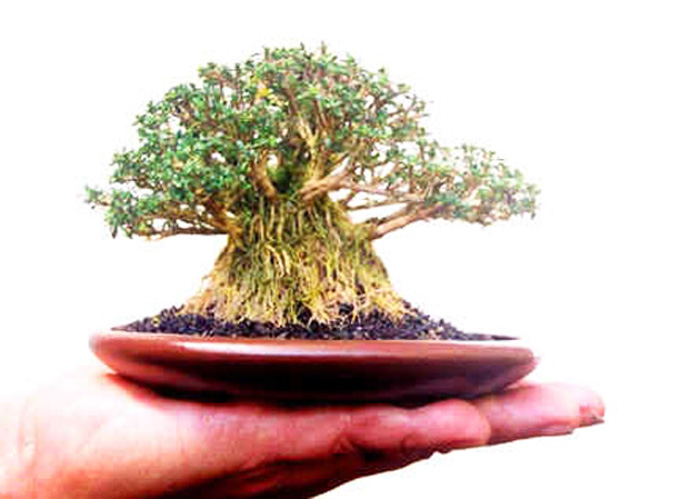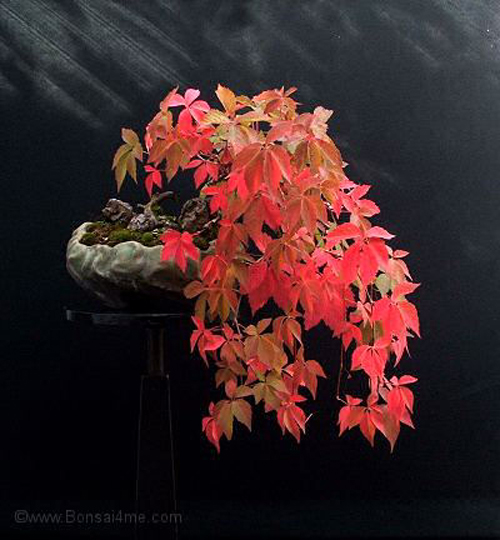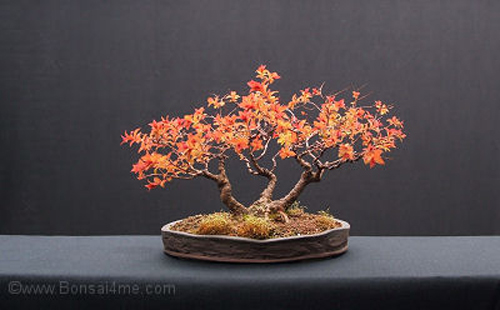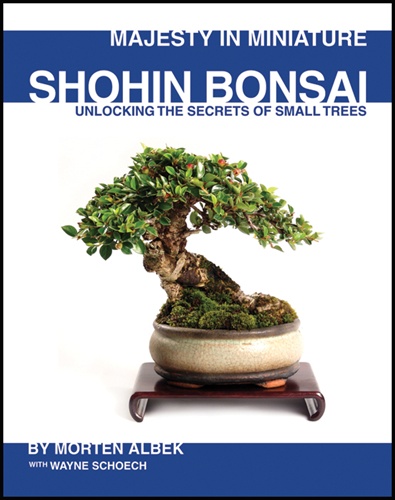 This banyan style dwarf Snow rose serissa (Serissa foetida microphylla) was styled by David Fukumoto of Fuku Bonsai in Hawaii. The pot is a Tokoname from Japan. Living in the tropics really helps when it comes to growing aerial roots.
This banyan style dwarf Snow rose serissa (Serissa foetida microphylla) was styled by David Fukumoto of Fuku Bonsai in Hawaii. The pot is a Tokoname from Japan. Living in the tropics really helps when it comes to growing aerial roots.
Based on thirty years experience in bonsai business, I’d guess that the majority of our readers and customers are into their middle years or beyond. To be sure, there are some younger bonsai enthusiasts, but clubbing and couch surfing don’t mix all that well with bonsai care. Nor do small children and the rigors of a budding fast track career. A slower more stable lifestyle that allows the time and space to properly care for bonsai works best (preferably after the kids have finally moved out somewhere in their mid-thirties).
Which brings us to aging backs and smaller bonsai. On the back cover of our Stone Lantern book Majesty in Miniature; Shohin Bonsai it says “When compared to large bonsai, Shohin cost less, take less time to develop, take less space, are easier to move, and are less apt to be over-watered. Perhaps best of all, Shohin-bonsai are a delight to behold.” Easier to move and better suited to the small balcony on the retirement condo. Practically small.
BTW: I’m not bemoaning aging backs or small balconies. I’m firmly in the let’s enjoy being alive school (without being stupid about it) and practicing bonsai, especially shohin bonsai, is a good way to enhance that enjoyment.
 Itoigawa juniper by Michael Hagedorn. Michael is one of our favorite American bonsai artists. If you haven’t visited his site (Crataegus Bonsai) this is as good a time as any. BTW: Michael is the author of Post-Dated – The Schooling of an Irreverent Bonsai Monk a fascinating read, bonsai or otherwise.
Itoigawa juniper by Michael Hagedorn. Michael is one of our favorite American bonsai artists. If you haven’t visited his site (Crataegus Bonsai) this is as good a time as any. BTW: Michael is the author of Post-Dated – The Schooling of an Irreverent Bonsai Monk a fascinating read, bonsai or otherwise.
 This small Viginia creeper by Harry Harrington (bonsai4me.com) is designed to show off the spectacular foliage.
This small Viginia creeper by Harry Harrington (bonsai4me.com) is designed to show off the spectacular foliage.
 This is the third time we’ve shown this Spiraea japonica (also by Harry Harrington). There are a couple reasons we returned to it: first, it’s a very sweet tree, and second, how many Spiraea bonsai have you seen?
This is the third time we’ve shown this Spiraea japonica (also by Harry Harrington). There are a couple reasons we returned to it: first, it’s a very sweet tree, and second, how many Spiraea bonsai have you seen?
 Morten Albek’s Shohin Bonsai. Published by Stone Lantern. Retail 24.95, our low price 9.95. Less the 10% to 30% off provided by our current site-wide sale.
Morten Albek’s Shohin Bonsai. Published by Stone Lantern. Retail 24.95, our low price 9.95. Less the 10% to 30% off provided by our current site-wide sale.
I enjoy reading this blog on a daily basis and have purchased through stonelantern before. I started to laugh a little though about the comments regarding age. I am in my earlier yrs and carry a busy full time job, have a wife and 3 younger children all at home, a full busy schedule and yet still find time (somtimes maybe to much depending who you ask) to devote to bonsai. I agree that clubbing and couch surfing dont mix well with bonsai and maybe Im taking it the wrong way but the way it was mentioned seemed like an unfair bias of the age group. Its guys like me and the many others around my age that are going to be needed in order to keep the true art of bonsai alive and going in the yrs to come. Guys in this age group is what will keep the true art of bonsai alive instead of it dying out (yrs in the future) and being over ran by corp. made “mallsai” for a quick buck. Bottomline is that there are bonsai dedicated super busy younger people out there and we do read your blog and love what stonelantern offers (best wire prices Ive found!). Thanks for all the articles and look forward to more as i always do. :)
It’s good to know that there are younger people out there ready to carry on doing bonsai like you, Erick but please don’t take Waynes’ words the wrong way. I know exactly what he means. I’ve been a member of two bonsai clubs and have met people from many more – both in Britain and here in New Zealand and I agree with Wayne. It seems to me the majority of bonsai people are in the ‘older’ generation. The younger ones that have joined clubs and been to conventions and shows are very enthusiastic but then life, work, family get in the way for a while until life starts to slow down then they can focus on bonsai again.
Thanks Erick,
Yeah. Agreed. Mostly I was just playing around amusing myself.
However, if you go to shows or clubs you will often find a quorum of grey and white tops (or smooth tops like me). Kinda makes sense too without over stating it.
I don’t think you have to worry about mallsai taking over either. The quality of bonsai in the West has improved dramatically in the 30 some years I’ve been involved. I suspect that trend will continue. Especially with the internet providing a way for us to bounce off one another.